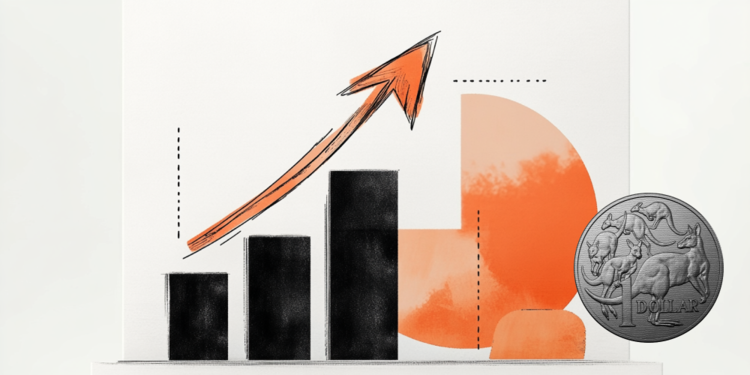- The Australian Dollar received a modest boost from mixed Australian employment data on Thursday.
- The number of employed people increased by 50,200, while the unemployment rate rose to 4.1%.
- The emergence of some USD buying keeps a lid on any significant upside for the AUD/USD pair.
The Australian Dollar (AUD) has been on a downtrend for the past week or so amid rising economic headwinds in China. Apart from this, falling copper prices proved to be another factor that weighed on demand for the resource-linked currency, although the recent fall in the US Dollar (USD) helped limit losses for the AUD/USD pair. In fact, the Dollar Index (DXY), which tracks the greenback against a basket of currencies, fell to a near four-month low on Wednesday amid dovish expectations from the Federal Reserve (Fed).
Market participants seem convinced that the US central bank will start cutting interest rates in September and reduce borrowing costs again in December. This keeps US Treasury bond yields depressed near a multi-month low, which, together with the prevailing risk environment, continues to weaken the safe-haven dollar. Moreover, the release of monthly employment details from Australia helps the AUD/USD pair stage a modest recovery from a two-week low retested during the Asian session.
Daily Market Wrap: Australian Dollar Struggles to Attract Buyers Following Mixed Domestic Employment Data
- Official data released by the Australian Bureau of Statistics (ABS) on Thursday showed that the unemployment rate rose to 4.1% in June compared with expectations and the previous figure of 4.0%.
- A slight disappointment, however, was offset by an unexpected rise in the number of people employed, from 39,700 in May to 50,200 in June, well above consensus estimates that pointed to a reading of 20,000.
- The mixed data, however, did little to influence expectations regarding the Reserve Bank of Australia’s next policy move, although it did provide a modest boost to the Australian Dollar and the AUD/USD pair.
- The US Dollar, on the other hand, is attracting some buyers and reversing some of the previous day’s heavy losses to a near four-month low, keeping a lid on any meaningful gains for the pair.
- Meanwhile, a September interest rate cut by the Federal Reserve is fully discounted and investors are betting on the possibility of two rate cuts by the end of the year, which should limit the USD’s upside.
Technical Analysis: AUD/USD manages to defend the support of the ascending trend line, ahead of the 0.6400 level
From a technical perspective, the AUD/USD pair is bouncing off the support marked by an ascending trend line. This, together with another ascending trend line, constitutes the formation of a rising wedge, a bearish pattern. Moreover, the oscillators on the said daily chart have just started to drift into negative territory and suggest that the attempted recovery is at risk of fading quickly.
Hence, any subsequent move higher is more likely to attract some sellers near the mid-0.6700 zone and remain capped. Some follow-through buying, however, has the potential to lift spot prices back towards the 0.6800 level, or a multi-month peak touched last week. Sustained strength beyond the latter will negate the near-term negative outlook and pave the way for the resumption of the previously well-established uptrend.
On the other hand, the mentioned trend line support, currently fixed near the round figure of 0.6700, could act as an immediate support. This is followed by the 50-day simple moving average (SMA), around the region of 0.6665, which if broken decisively will be seen as a fresh trigger for bearish traders. The AUD/USD pair could then accelerate the decline towards the 100-day SMA support near the level of 0.6600.
Australian Dollar FAQs
One of the most important factors for the Australian Dollar (AUD) is the level of interest rates set by the Reserve Bank of Australia (RBA). Since Australia is a resource-rich country, another key factor is the price of its largest export, iron ore. The health of the Chinese economy, its largest trading partner, is a factor, as is inflation in Australia, its growth rate and the Trade Balance. Market sentiment, i.e. whether investors are betting on riskier assets (risk-on) or seeking safe havens (risk-off), is also a factor, with risk-on being positive for the AUD.
The Reserve Bank of Australia (RBA) influences the Australian Dollar (AUD) by setting the level of interest rates that Australian banks can lend to each other. This influences the level of interest rates in the economy as a whole. The RBA’s main objective is to maintain a stable inflation rate of 2%-3% by adjusting interest rates up or down. Relatively high interest rates compared to other major central banks support the AUD, and the opposite for relatively low ones. The RBA can also use quantitative easing and tightening to influence credit conditions, with the former being negative for the AUD and the latter positive for the AUD.
China is Australia’s largest trading partner, so the health of the Chinese economy greatly influences the value of the Australian Dollar (AUD). When the Chinese economy is doing well, it buys more raw materials, goods and services from Australia, which increases demand for the AUD and drives up its value. The opposite occurs when the Chinese economy is not growing as fast as expected. Therefore, positive or negative surprises in Chinese growth data often have a direct impact on the Australian Dollar.
Iron ore is Australia’s largest export, worth $118 billion per year as of 2021 data, with China being its main destination. The price of iron ore can therefore be a driver of the Australian dollar. Typically, if the price of iron ore rises, the AUD rises as well, as aggregate demand for the currency increases. The opposite occurs when the price of iron ore falls. Higher iron ore prices also tend to lead to a higher probability of a positive trade balance for Australia, which is also positive for the AUD.
The trade balance, which is the difference between what a country earns from its exports and what it pays for its imports, is another factor that can influence the value of the Australian dollar. If Australia produces highly sought-after exports, its currency will gain value solely because of the excess demand created by foreign buyers wanting to purchase its exports versus what it spends on buying imports. Therefore, a positive net trade balance strengthens the AUD, with the opposite effect if the trade balance is negative.
Source: Fx Street
I am Joshua Winder, a senior-level journalist and editor at World Stock Market. I specialize in covering news related to the stock market and economic trends. With more than 8 years of experience in this field, I have become an expert in financial reporting.







